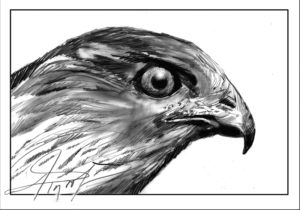By Susan Shea
One late winter day, I heard our dog barking fiercely from the yard. I went outside to find him standing about 6 feet away from a hawk that was on the ground beside our house. I grabbed the dog’s collar, brought him in, and observed the hawk through a window. It was an immature sharp-shinned hawk, about a foot long, with a dark brown back, vertical streaks on its white breast, and piercing yellow eyes. The hawk had likely crashed into the house while trying to catch a bird at our feeder. I thought perhaps it was stunned and would recover in a little while.

Sharp-shinned hawks are North America’s smallest accipiters, a group of hawks identified by their short wings, long tails, and a distinctive flight silhouette. In contrast to the hawk in our yard, adult sharp-shinned hawks have a slate-gray back and orange, horizontal bars across the breast. Both adults and juveniles have black bands on their long, square-tipped tails. It can be challenging to distinguish a sharp-shinned hawk from its larger cousin, the Cooper’s hawk, which has similar coloration, but a rounded tail tip. Female sharp-shinned hawks are one-third larger than males, and can approach the size of a male Cooper’s hawk.
Sharp-shinned hawks are found year-round in all but the very northern portions of the Northeast. Birds that breed in Canada and extreme northern New England winter in the southern United States, and as far south as Central America. Those that migrate take advantage of updrafts along ridgelines and may form small flocks. They are one of the most common hawks seen at fall hawk watches. Sharp-shinned hawks breed in dense forests and prefer conifer trees for nesting. As a forest-dependent species, they are vulnerable to heavy logging and forest fragmentation caused by development.
Author and ornithologist Arthur Cleveland Bent, writing in 1937, described the sharp-shinned hawk as a “bold and dashing little hawk, the terror of all small birds.” These raptors use the element of surprise while hunting. They can fly at speeds of up to 28 mph and are skilled at maneuvering through thick woods. They conceal themselves in trees along forest edges, including on low perches, and ambush passing prey. They fly low over open areas, hiding behind contours, and pop up to snatch a bird from the air or off a branch in their talons.
During winter, sharp-shinned hawks hunt small birds and mammals along woodland edges and sometimes at bird feeders. In addition to the hawk that hit our house, I’ve seen several other sharp-shinned hawks perched in trees near our feeder over the years. The rise in popularity of bird-feeding may have increased populations of this hawk and enabled them to winter further north than in the past. Songbirds make up 90% of the sharp-shinned’s diet.
They also consume mice, voles, and occasionally grasshoppers and moths and will prey on the nestlings of other birds when raising their own young. Though sharp-shinned hawks mainly hunt small birds, they have been known to kill larger birds. I once witnessed a prolonged interaction between a sharp-shinned hawk and a pileated woodpecker. The hawk repeatedly flew at the woodpecker, which kept hopping around the tree trunk to dodge the attacks. Eventually the hawk was disturbed by a human approaching and flew away.
It turned out that the hawk in our yard was not simply stunned, but also injured. A couple of hours after discovering it, I went outside again. The hawk began hopping around our fenced-in yard, extending one wing, but not the other. It appeared to have a broken wing, and couldn’t fly. I called the game warden, and he gave me the name of a local wildlife rehabilitator experienced with raptors, who was able to capture the injured hawk with a net. He skillfully cradled the bird in his arms before putting it in a pet carrier for transport.
If you keep an eye on your bird feeders and surrounding trees, you may also be treated to a glimpse of this agile hunter.
Susan Shea is a naturalist, writer, and conservationist based in Vermont. Illustration by Adelaide Murphy Tyrol. The Outside Story is assigned and edited by Northern Woodlands magazine and sponsored by the Wellborn Ecology Fund of the New Hampshire Charitable Foundation: nhcf.org.




